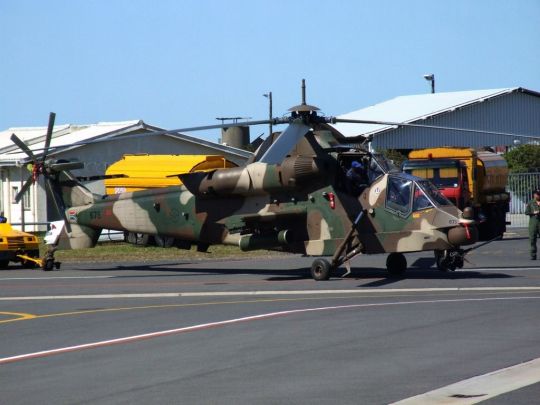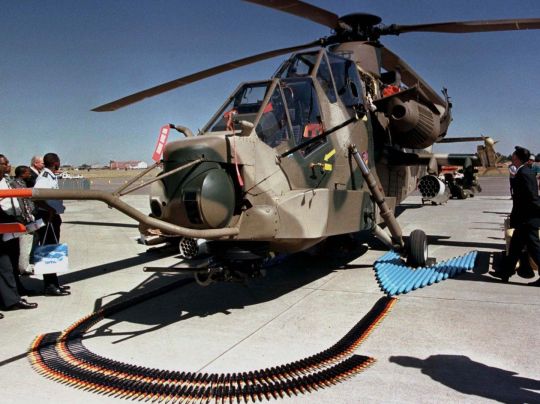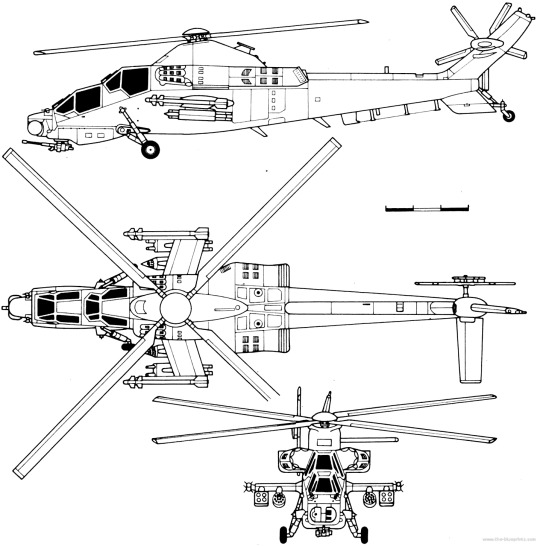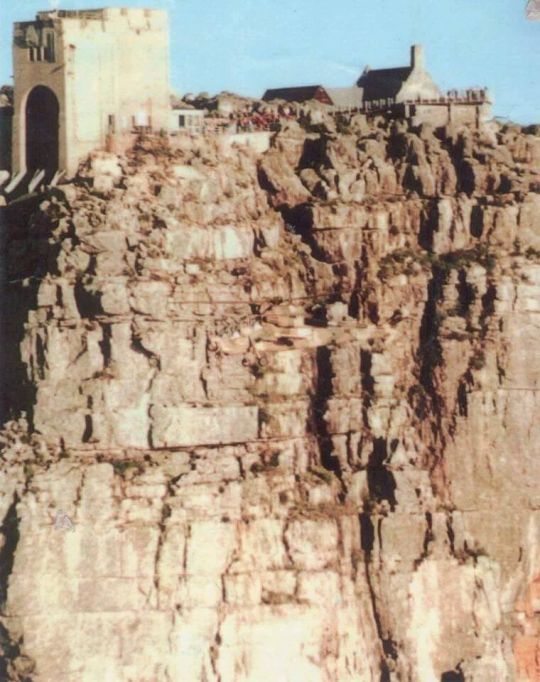#atlas rooivalk
Text
FLIGHTLINE: 204 - DENEL ROOIVALK MK.1

-A Denel Rooivalk of the SAAF. | Photo: Bob Adams
Beginning around 1984, the South African Defence Force began development of a modern attack helicopter, capable of escorting troop transports as well as taking out ground targets. Due to an arms embargo resulting from South Africa's policy of apartheid, importation of foreign aircraft were banned, so a domestically-built chopper was needed. Atlas Aircraft Corporation (now Denel Aviation) investigated basing a potential helo on two models already in use by the SADF, the Aérospatiale Alouette III and the Aérospatiale SA 330 Puma. The Alouette III, a light utility copter from the 1950s, was considered a poor choice for development, as it was an out-of-date design with underpowered engines. The Puma was more favored as it was a more modern helicopter; Atlas was also working on the Oryx, a localized model of the Puma roughly equivalent to the Eurocopter Super Puma, which added to the decision to proceed with Atlas's plan to develop an attack helicopter based on the Oryx/Puma.
ALPHA, BETA
Before beginning the work of adapting the Puma, Atlas produced the XH-1 Alpha, which was a proof-of-concept aircraft based on the Alouette III. The Alpha retained the engines, rotors and aft fuselage of the Alouette, but added a two-place stepped cockpit, a 20mm cannon in a turret, and removed the original skids in favor of a tricycle undercarriage. The Alpha's maiden flight was on 3 February 1985, and an extensive series of trials convinced the South African Air Force that developing and operating an indigenous attack helicopter was feasible. The Alpha was retired in the late 1980s and placed on display at the SAAF Museum.

-The Atlas XH-1 Alpha on display. | Photo: Darren Olivier
Following-up on the Alpha, Atlas began work on the XTP-1 Beta, modifying two SA 330 Pumas with stub wings, gun turret and targeting systems, along with certain aerodynamic changes. The two Betas were used in weapons trials, as well as giving Atlas/Denel knowledge and experience in producing the advanced components of modern attach helicopters. Fitted with four 68mm rocket pods, a 20mm cannon aimed by helmet sights and two air-to-air missiles, the XTP-1s first flew in 1987. Later refinements saw the addition of a laser designator and two pods of four each of the ZT3 Ingwe ATGMs, developed by Kentron (now Denel). The XTP-1 has the distinction of being the first South African helicopter to fire an air-to-air missile, the Kentron V3B Kukri.

-One of the XTP-1 prototypes. | Photo: Atlas Aircraft Corp.
RED KESTREL
With the success of the Alpha and Beta test helicopters, Atlas now was set to proceed with developing a true attack heli. Construction of the XH-2 prototype began in the late 1980s, with the maiden flight occurring on 11 February 1990. After the rapid progress sustained from 1984, however, development of the XH-2, now called the Rooivalk ("Rock Kestrel" or "Red Kestrel") slowed as defense budgets were slashed. The Border War, which had driven South Africa's desire for a helicopter in the first place had ended in 1988, leading to a reduction in orders for the Rooivalk from 36 to just 12 choppers. The desire to build a cutting edge aircraft also resulted in a slow gestation period and high cost per vehicle, which later affected potential export contracts. Never the less, Atlas (later Denel) pushed ahead, and the XH-2 took its maiden flight on 11 February 1990.

-The XH-2 prototype on display with a representative weapons load. | Photo: Denel Aviation
DESIGN AND SPECIFICATIONS
The Rooivalk is broadly reminiscent of the AH-64 and other attack helicopters, possessing a long and narrow fuselage, a two-man cockpit with the gunner/weapons operator placed in front of the pilot, and two stub wings to carry weapons. The fuselage itself is 16.39 meters long, and the Rooivalk is 18.73 meters overall, including the 15.58 meter diameter main rotor. The fuselage and rotors are composed of both metal and composite materials. Empty, the helicopter weighs 5,700kg, while at full load it weighs 7,500kg. One thousand eight hundred liters of fuel are carried internally, giving the Rooivalk a combat range of 740km, which can be increased to 1,260km with external tanks. Power is provided by two Turbomeca Makila 1K2 turboshaft engines rated at 1,420kW each, giving the helo a top speed of 309kmh, a cruise speed of 278kmh, and a service ceiling of 6,100m. Wirecutters are mounted above and below the cockpit and on the undercarriage as well. The aircraft is aerobatic, fully capable of performing a loop and thus flying upside-down momentarily. A 20mm F2 autocannon with 700 rounds is fitted as standard, and two hard points under each of the stub wings can carry launchers for the ZT-6 Mokopa laser guided anti-tank missile, 70mm rocket pods, or drop tanks. Two rails on the tips of the wings can mount Denel V3E A-Darter or MBDA Mistral IR air-to-air missiles. An electronic countermeasures suite is fitted, with both chaff and IR decoy launchers. An advanced navigation system incorporating Doppler radar and GPS allow the Rooivalk to both hover and land automatically, as well as permitting the helicopter to fly at high speed at altitudes under 15 meters. Denel designed the Rooivalk with survivability and robustness in mind, and the helo is capable of operating at austere positions, supported by only four ground crew and basic supplies; the entire load could be carried by a medium transport copter like the Oryx.

-Orthograph of the Denel Rooivalk. | Illustration: Dr Dan Saranga
ACCEPTANCE AND OPERATIONS
Eight years of test flights, acceptance trials, and production issues occurred before the first Rooivalk Mk.1 entered service with the SAAF, though by April 2005 only 6 were available for evaluation, with the other 6 awaiting software patches. In August of the same year, one of the aircraft was written off after an uncontrolled landing. Lt. Gen. Carlo Gagiano, Chief of the South African Air Force, expressed hopes that the remaining eleven Rooivalk would all be operational some time in 2007 and was concerned that the financial difficulties and high staff turnover at Denel had resulted in an "extremely worrying factor of time that the project was taking to reach maturity". A lack of interest in the helicopter on the international market, due to the embargo against South Africa and rumored pressure by the US in favor of its AH-64 Apache, saw Denel abandon plans to sell the Rooivalk internationally, and on 17 May 2007 ceased further development of the type.

-The tan, brown and green camouflage of the Rooivalk blends in perfectly with Table Mountain. | Photo: South African Air Force
An investment of 962 million South African Rand ($137 million USD in 2007) by the South African government was announced in November of that year, expected to see the 11 remaining aircraft brought up to full operational capacity by 2011. Delivery of the first Rooivalk upgraded to Block 1F, which addressed problems with the F2 cannon, upgraded the transmission, improved the targeting systems and avionics and added compatibility with the Mokopa missiles, occurred on 1 April 2011, with the last being delivered on 13 March 2013. Later that year, three Rooivalks were deployed with the United Nations Force Intervention Brigade to support the United Nations Organization Stabilization Mission in the Democratic Republic of the Congo. On 4 November 2013, two Rooivalks with the United Nations Force Intervention Brigade fired FZ 90 70mm FFAR rockets on M23 positions near Chanzu.

-Two SAAF Rooivalk, in UN white, are photographed escorting a UN delegation over the Congo in 2014. | Photo: MONUSCO/Clara Padovan
In 2016 Denel signed an agreement with Airbus Helicopters to cooperate on development of the Mk1.1 upgrade of the Rooivalk, with improvements in reliability and survivability, an increased payload, and the replacement of obsolete targeting systems and armaments being top priority. Denel has also been in talks with a number of nations, including Egypt, Brazil, Nigeria, Poland, and India, to gauge support for reopening the Rooivalk production line for a new-build Mk.2 variant, which would incorporate the Mk1.1 upgrades as well as compatibility with a wider array of munitions and other modifications. Denel has indicated that a commitment of at least 70 helicopters would be needed to reopen the lines. As of 2021 these new orders have not yet materialized, leaving the SAAF 16 Squadron the only operator of the Rooivalk.
#Aviation#aircraft#helicopter#attack helicopter#attack chopper#south africa#south african air force#atlas aircraft#denel#1980s#atlas rooivalk#denel rooivalk#rooivalk
12 notes
·
View notes
Link
AH-2 Rooivalk is considered not inferior to the leading attack helicopters in the world today. The Denel Rooivalk, previously designated AH-2, is an attack helicopter developed began in 1984 by Atlas Aircraft Corporation, the forerunner of the current Denel Aviation Group of South Africa. At the time, South Africa was under an arms embargo enacted by United Nations Security Council Resolution 418 due to its policy of apartheid, which prevented foreign combat helicopters from being imported. The South African Defence Force recognised the need for a dedicated attack helicopter and accordingly began the process of developing a suitable aircraft.
0 notes
Video
Atlas Alpha XH-1 [unmarked] by Alan Wilson
Via Flickr:
c/n 001. A Prototype attack helicopter design, the XH-1 used mechanical components etc from an Alouette III. It was used as a concept demonstrator for the Rooivalk, which was developed from the later XH-2 and later went into limited production. The original XH-1 has survived and is now on display in Hangar 1 at the South African Air Force Museum. Swartkop Airfield, Pretoria, South Africa. 19-9-2014
0 notes
Photo

First flight of the Atlas XH-1 Alpha, a South African prototype attack helicopter, used as a concept demonstrator for the then-planned Rooivalk project.
0 notes
Video
Atlas Alpha XH-1 [unmarked] by Alan Wilson
Via Flickr:
c/n 001. A Prototype attack helicopter design, the XH-1 used mechanical components etc from an Alouette III. It was used as a concept demonstrator for the Rooivalk, which was developed from the later XH-2 and later went into limited production. The original XH-1 has survived and is now on display in Hangar 1 at the South African Air Force Museum. Swartkop Airfield, Pretoria, South Africa. 19-9-2014
0 notes
![Atlas Alpha XH-1 [unmarked]](https://live.staticflickr.com/645/22576580347_103294f58b_b.jpg)
![Atlas Alpha XH-1 [unmarked]](https://live.staticflickr.com/5626/22995007275_5ba01da857_b.jpg)